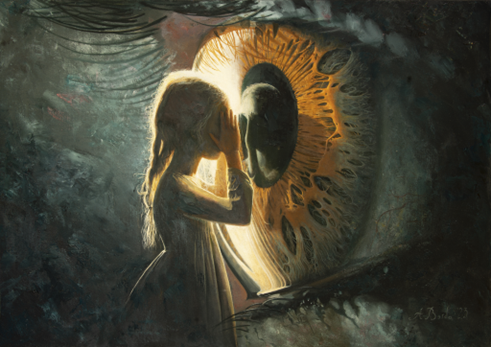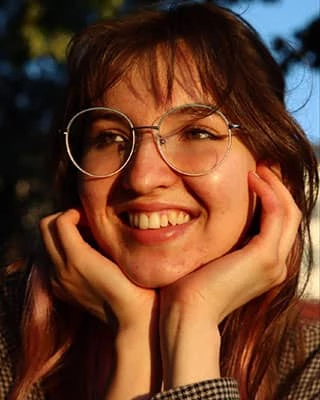
Cover artist of Apex Magazine for the third time is Adrian Borda, a Romanian artist who refers to himself as an “inner traveler,” exploring the subconscious world in and out of his work. The piece on this month’s cover is “All We Ever Believed In,” an oil painting that provokes consideration of the endless abundance of thoughts in the human mind.
Bradley Powers: In a previous interview with us you mentioned projecting emotions into inanimate objects instead of living beings. In this issue’s cover piece, “All We Ever Believed In,” the focus is a girl but her back is turned which means the viewer has no facial expression to read. This seems strategic in terms of making the viewer project their ideas into the piece. What other strategies do you have to pull your viewers into your work?
Adrian Borda: The more you let the viewer’s mind contribute to the creation, the more involved the viewer will be; I will capture their attention and create new interesting meanings in the image. Ideally there should be a hook to capture your attention and draw you in so that you lose yourself in the riddle.
BP: You specialize in two extremely different areas in art: photography and surreal painting. Photography shows replications of the real world, and surrealism alters reality to create new meanings. Where did your interest in each of these fields begin? How does working on both simultaneously affect the work?
AB: I’m very visual, and I’m interested in almost everything related to visual art, but on social media I post only painting and photography. I find it impossible to find a meaningful starting point to my journey in art, and there might never be a clear end of it. I believe the journey of discovery, becoming aware, and realizing that what you perceive is an interpretation in your mind of the impulses from the external world, whatever it might be out there. Learning to paint is understanding the visual at a completely new level. It’s like an awakening … You realize that before you were not aware of what you saw, and can’t even remember how you saw the world before, just like how you have no memories before the age of three or four when you start learning language and understanding meaningful concepts. Photography helped a lot, as it gave me another level of understanding, but in most cases I process the images quite a lot. It’s not just a hunt for the perfect moment like the nature photographers do, where there is minimal post production. That is a waiting game to press the shutter in the best moment possible with the right camera settings. I find that too time consuming and involving too little creativity to be worth doing. I prefer combining different images to make a scene with new meanings—this way it is a bit closer to painting.

BP: Have you ever considered combining photography and oil painting in the form of digital painting or collage? What makes oil painting and photography your media of choice?
AB: I do digital painting, but never seriously considered combining it with oils. I can’t wait for artificial intelligence to open new portals of expression in augmented reality and virtual reality. I’ve tried 3D software as Maya, but it is very time consuming to make something—you need an entire studio and team like Pixar! I believe artificial intelligence will make this process much smoother, as it already does with Midjourney, for example. It is impossible to express what you really want in a few words, but the not-so-distant future might be really mind blowing.
BP: Looking through your work and reading the captions on your Instagram posts, it seems as though spirituality is a huge motivator of your creativity. What is the process of finding an idea spiritually and translating that into a work of art? Do you intend for your viewers to take the same meaning from the work that you put into it?
AB: For me spirituality is putting matter into flames; I try to understand the scientific view of the world and stick to it as the base of my reality, as I don’t want to slip into the New Age bullshit all my friends do. Simultaneously, I try to find the meaning of my inner world, and if I can’t find one, I create one worth living for. For me, it is more like an eternal puzzle—if I were to find the ultimate truth I probably would try to forget or deny it, just to find it again and again. Not long ago I put no description with my paintings, because there might be much more in the image than I can express in a few words. More than anything I don’t want my paintings to be a mystery, however I was a little bit disappointed by the shallow interpretations I saw in the comments. Maybe this is because people jump from image to image for the dopamine rush without taking much time to reflect upon them. People love stories, so I felt the need to write some beside the paintings, but I believe that a painting should transmit something by itself with no title or description. Some images can be quite complex and if the viewer doesn’t have the same cultural background and symbolic understanding, they might see something different than I do. Sometimes I find deep meanings long after I finish a painting—the subconscious and its connections and messages are a never-ending surprise.
BP: Thank you, Adrian, for this meaningful peek into the process behind your stunning works of art! If you want to dive into more of Adrian’s work, check out his DeviantArt, Instagram, and website. You can read Russell Dickerson’s past interviews with Adrian on the Apex Magazine website. The issue 71 interview can be found here. The issue 93 interview can be found here.










